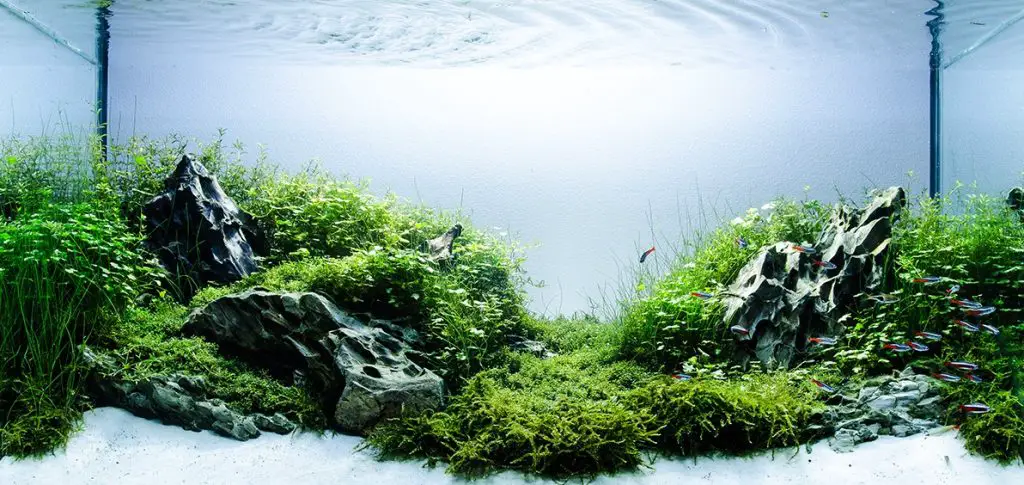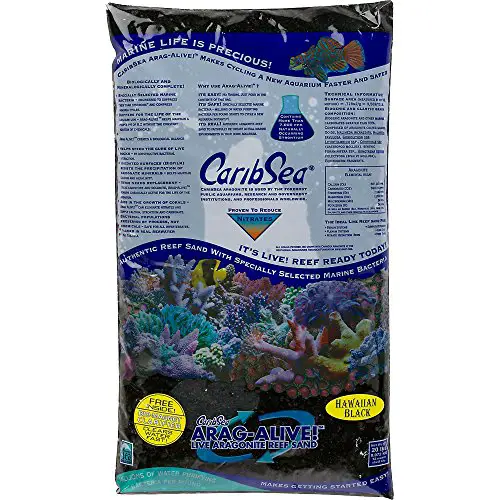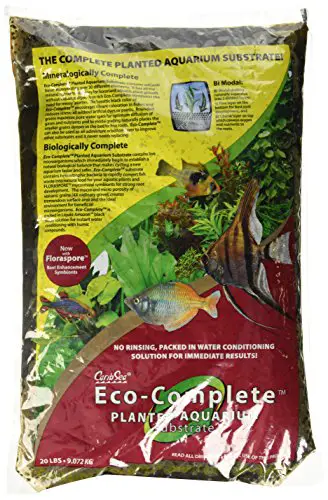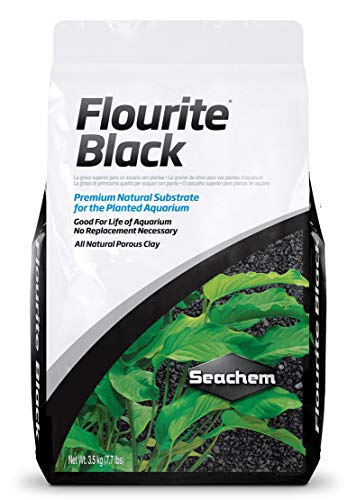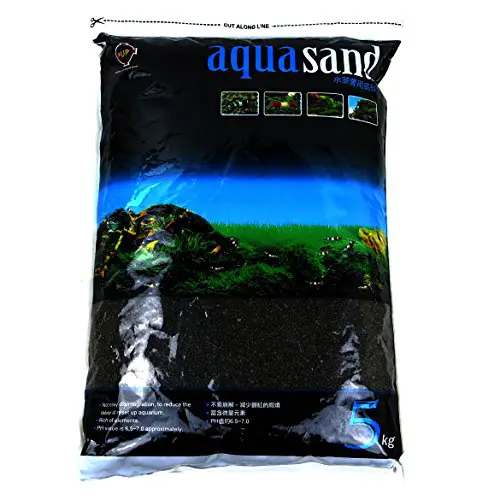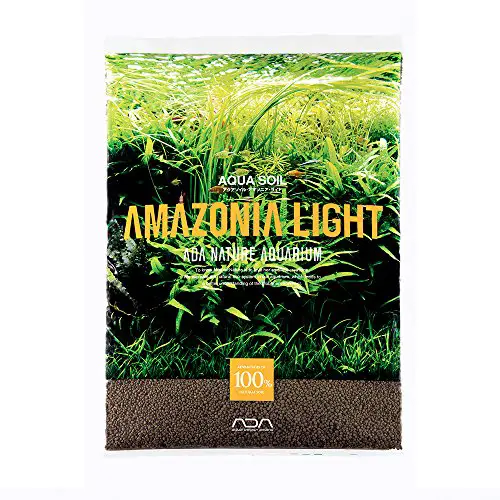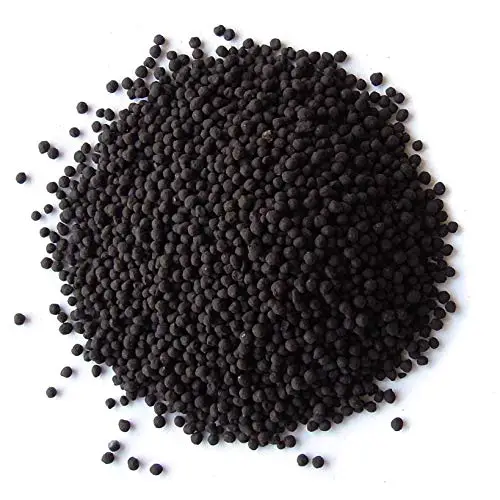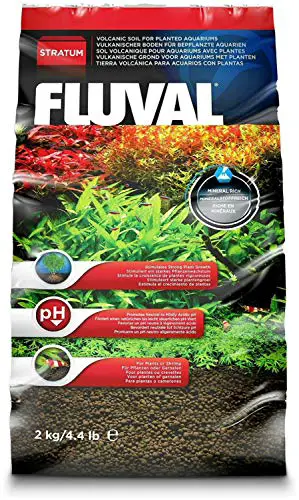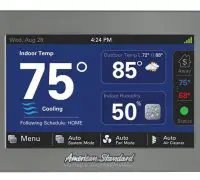It doesn’t take to be a rocket scientist to know that all plants have a form of the root system. The systems can be complicated or simple, but, either way, all plants have one.
No matter the complexity of the systems, the roots are fundamental for the nutrient intake, which is why the plants can stay alive and healthy.
If for land plants, the soil is what they need for the root system, for aquatic plants, is it the same? What substrate to plants in your aquarium need for thriving? Keep reading for the details!
Page Table of Contents
TOP 7 Best Substrate for Planted Aquarium
1. Carib Sea Arag-Alive Substrate
For those of you looking for an active substrate for their marine aquariums, the Carib Sea Arag-Alive Substrate is one reliable option to check.
The substrate works for both marine and African cichlid aquariums, and its formula is impressive. It contains beneficial marine bacteria which will improve the biological filtration in your planted aquarium. It’s a solid substrate for many freshwater aquaria, but also for water turtles, tetras, discus, rays, cichlids, and plants.
It’s wet, and it’s not all black, making the bright colors of corals pop out. It doesn’t contain any shell fragments and stays clean for a fair amount of time. It’s heavy enough to hold the rocks and speeds up the cycling of your aquarium.
The substrate looks beautiful, and the beneficial bacteria within the formula make it highly functional too.
Let’s go over the functional aspects once more:
- It contains beneficial bacteria
- It’s reliable for freshwater aquaria, tetras, water turtles, and so on
- It makes corals pop-out
- It stays clean and speeds up the cycling
Don’t mind the flaws as they’re minor:
- Some little cloudiness for a couple of hours may occur
- It’s not all black, which isn’t such a bad thing
Affordable, dependable, and nice-looking, the active substrate is one reliable option to write down on your shopping list.
2. Carib Sea Eco-Planted Black Aquarium Substrate
The popularity of the Carib Sea Eco-Complete Planted Black Aquarium Substrate speaks volumes, and we can totally get it why.
For an excellent price, you get a complete substrate for freshwater planted aquarium, which includes minor and significant trace elements that help your plants grow. The substrate nourishes the aquarium plants, sustaining healthy growth.
It’s a new formula that encourages root development since it contains basaltic volcanic soil with calcium, iron, potassium, magnesium, and sulfur. The list of ingredients also includes another 25 elements which nourish the aquatic plants.
The substrate is both biologically and mineralogically complete, helping the plants thrive without nuisance algae. It’s iron-rich, so you no longer have to add laterite. The Heterotrophic bacteria within the formula will turn the fish waste into natural food for your aquatic plants really fast.
The formula doesn’t contain any chemical coatings, paints, nor dyes. It has highly porous spherical grains that diffuse efficiently. Moreover, the substrate restores the natural biological balance in your aquarium for faster and safer cycling.
It’s easy to use the substrate. You only need to empty the aquarium, add the water and the plants, running all the pumps and filters. Should you decide to add it to an existing tank, it’s better that you add a couple of pounds any now and then throughout a week or more.
Here’s what we like the most about it:
- It contains minor and major trace elements that feed aquarium plants
- The formula is based on basaltic volcanic soil and 25nourishing elements
- It’s easy to use, settling quite fast
- It requires low maintenance and looks great
Don’t worry about the downsides since they’re minor:
- Your aquarium may be foggy for a while
- Some notice that it may raise the pH
Regardless of the small problems, the substrate is a dependable, efficient, and nourishing option that helps your aquatic plants thrive.
3. Seachem Flourite Black Clay Gravel
Even if Seachem Flourite Black Clay Gravel may require some work, it’s still a reliable option for your planted aquarium.
It’s a specially fracted stable porous clay gravel which works amazingly in natural planted aquariums. Due to its appearance, you can use it for both planted aquarium and freshwater aquarium environments.
You don’t need to use gravel modifiers (laterite is one) when using Seachem Flourite Black gravel. As a matter of fact, it’s more efficient when working alone as an integral substrate bed. However, you can mix it with other gravels.
The gravel is pre-washed, but it’s still a natural product that may become dusty in transit. Therefore, some rinsing may be necessary for removing residual dust.
As you’re adding water to your aquarium, you may gently fill it without disturbing the substrate bed. Put a bowl in the aquarium and pour water right into the pot so that it overflows gently on to the gravel bed. The cloudiness is typical at first, and don’t hesitate to use mechanical filtration for better results.
The gravel works fine with under gravel filter, without decomposing nor softening. It’s not treated nor chemically coated so that it won’t alter the pH of water. Thanks to its formula, you won’t have to replace it either.
Let’s have another look at the best parts:
- It’s porous clay gravel for planted aquariums and freshwater
- You can use it alone or together with other gravels
- It’s natural and looks nice
- It’s not chemically coated and doesn’t alter the pH of the water
The inherent flaws are nothing to worry about:
- It’s sharp, so pay attention while handling it
- It may need rinsing
All in all, the substrate is a good option for many planted aquariums, and you should give it a try.
4. UP AQUA Sand for Aquatic Plants
Unlike other substrates, the UP AQUA Sand for Aquatic Plants doesn’t lead to dust release when you place it in the aquarium. The risk for clouding the water is rather minimal, and the water remains nice and clear as the substrate is setting.
The substrate has a unique formula for aquatic plants, maintaining the pH at 6.5 for best plant growth. It doesn’t break down quickly, either. You don’t need to rinse it before using, which only eases out the release.
The formula contains several nutrients that are enough for the healthy growth of your aquatic plants. You don’t need to worry about adding other substrates or nutrients for sustaining a healthy growth of the mini-ecosystem inside your aquarium. The formula is enough for your plants to nourish.
The substrate has a round, porous, and light texture, which is why it can easily support the roots of the aquatic plants. It’s great for sustaining a healthy root development, for increased stability of the plants.
Due to its formula, the substrate it’s also capable of keeping and controlling the pH level of the water. It can reduce the pH level to 6.5-7.0, which is neutral and only slightly acidic. In case you don’t know, it’s the ideal pH for many aquatic plants and fish.
The substrate takes the use for a fair amount of time and looks very nice. It’s easy to plant into and dust-free.
Here’s our take on the pros:
- It’s great for supporting roots and gives stability to the plants
- It controls and keeps the pH level of the water
- It’s easy to plant into
- It looks beautiful and has a porous texture
We’re not backing down over some small shortcomings:
- It’s rather grey under the light
- Some think it’s not cheap
For what it’s worth, the substrate is dependable and comes with many good things, which is why you should try it sometimes.
5. ADA Aqua Soil Amazonia Light
Even if you may have to use something else for your planted aquarium, the ADA Aqua Soil Amazonia Light (9 Liter) Normal Type is a nourishing option for your plants, helping them grow healthier than ever.
The natural earth color looks so lovely, giving a natural feel to your planted aquarium. It’s a rare Japanese plant-based black soil that sustains growth for most aquatic plants. The formula includes rich organic ingredients and nitrogen level, which encourages the growth of your aquatic plants. It makes the water just slightly acidic, benefiting tropical fish and plants.
It’s an excellent choice for the entry-level aquarists and improves the looks of entirely planted aquariums. It doesn’t change the color of water but keeps it crystal clear.
Let’s go over the best parts once again:
- It’s made with plant-based black soil
- It sustains healthy growth for most plants, and it’s safe for tropical fish
- It has a beautiful earth color
- It maintains the water crystal clear, and it benefits pH level
For the sake of fair play, we also list the downsides:
- The instruction could be better
- You cannot rely exclusively on it for your plants
Regardless of the minor problems, the substrate looks beautiful and is suitable for the healthy growth of your plants. Why not take the plunge?
6. Ultum Freshwater Planted Aquarium Substrate
The Ultum Nature Controsoil Freshwater Planted Aquarium Substrate has a formula based on andisol made from Japanese volcanic ash. You can get in black or brown, but both colors help you create various shades for your plants and fish.
Thanks to its formula, the substrate can balance the level of pH, benefitting not only aquatic plants, but also shrimp and freshwater fish. You shouldn’t use it in a saltwater tank, though.
The substrate is useful for absorbing the impurities in your planted aquarium, working as an effective media. It eliminates ammonia, and its texture lets the plants to attach roots.
As long as you’re using it correctly, there’s no need to rinse the substrate. It will not clod up the water either, but you may not want to use it for fish that love digging.
From the moment you’re placing it in the planted aquarium, you will notice a healthier growth for your fish and plants. It comes with three different granules, ranging from 1 to 5mm.
We’ve shortened the pros to the following:
- It’s excellent for the healthy growth of plants and fish
- It’s safe for shrimps and freshwater fish
- It doesn’t cloud up the water and doesn’t require rinsing
- You can choose from three different granule sizes
The downsides shouldn’t make you change your mind:
- It’s not the cheapest substrate
- It may be too light for some plants
Stay focused on the goods since they outweigh the bads, and don’t hesitate to give the substrate a try.
7. Fluval Plant and Shrimp Stratum
Should you have a planted aquarium and worry for your shrimps too, the Fluval Plant and Shrimp Stratum, 4.4 Pound, is a safe and effective substrate to use.
The substrate is made for freshwater aquariums, controlling organic discoloration without endangering the newborn shrimp.
The formula is based on mineral-rich volcanic soil that doesn’t discolor water but sustains plant growth. It provides the newborn shrimps a safe refuge from predators while helping plants and nitrifying bacteria thrive. Thanks to the formula, the substrate also sustains neutral to mildly acidic pH.
The plants in your aquarium will penetrate and spread throughout the substrate, nice and easy. The Fluval plant micronutrients provide both micro and macronutrients that are essential for aquatic plants.
It’s a non-compacting, light, and porous substrate that is effective for nitrifying bacteria, improving the quality of water. It also looks fantastic and sustains organic discoloration control, which happens with natural driftwood.
We should highlight the best parts once more:
- It’s excellent for freshwater planted aquariums and safe for newborn shrimp
- It encourages plant growth
- It offers young shrimp refuge
- It looks beautiful and sustains neutral to mildly acidic pH
Don’t make a tragedy out of the minor issues:
- It may lead to a dust explosion with every movement
- Not all plants may thrive
Even if the substrate isn’t all roses and rainbows, it’s still a great and safe option for planted aquariums and shrimps that you shouldn’t miss.
How to select the substrate for your planted aquarium?
The variety of substrate for planted aquarium goes from the simple to the exotic type, so you really need to do your bits and bobs before buying.
Substrates create a base for your plants’ roots, but also a home for bacteria. Bacteria bio-film will bind tiny particulate matter, turning the substrate into a capture point. The organic debris will be broken down into nutrients that plants can use for growing.
On top of everything else, the substrate has an aesthetic function, making your planted aquarium look better, which is only one more reason for which you should select it carefully.
Here are the main aspects to pay attention to when choosing the substrate for your planted aquarium:
- Weight
It depends a lot on the plants in your aquarium, but you never want the substrate to be too light as your plants won’t be able to grow roots. Some plants are quite fragile and have short roots, in which case a very light substrate won’t do.
- Grain size
More often than not, 2mm is considered to be a decent size for the substrate. Generally speaking, anything from 1 to 3mm should work in a planted aquarium.
You should stay away from the substrate and that is too fine, as it compacts too easy. Moreover, livestock in your aquarium will stir way too quickly the extremely fine sand. It doesn’t mean that you should go with pea gravel, which is too coarse for the small plants that have a delicate root system. They will not root nor thrive in pea gravel.
- Material
Most material is inert, and some recommend not to use coral sand/limestone chips. You should only use them if you’re determined to raise the KH values in your aquarium. When it’s not clear for you which material is best, have an acid test so that you find out if it’s carbonate-based or not.
- CEC value
CEC (Cation exchange capacity) refers to the substrate’s possibility to bind ions (fertilizers, for instance), maintaining them in a proper format for plants.
Even if some manufacturers praise the high CEC value of their products, CEC isn’t fundamental. It’s because most of the CEC in inert substrates are produced by organic humus, which collects in the inert substrate after some time. If you’re looking for more efficiency, it’s better that you add a thin layer of dirt under the plain sand/gravel. You’re going to have better results.
- Aesthetics
It’s not fundamental, but the appearance of the substrate can make your planted aquarium look a lot better. You need to do some planning if you’re trying to achieve a layered aquarium. For instance, a blackwater aquarium looks more appealing with a combination of earth-colored mixed grain sands. Go with the black substrate when you have brightly colored plants.
Don’t forget that the substrate also has to match the hardscape. For example, white/grey sands look way better with black/dark rocks than brown.
Which type of substrate works best for your planted aquarium?
Truth be told, it’s not easy to talk about the main categories of the substrate, simply because you may make substrate with whatever material you’re thinking of.
However, let’s check the most relevant categories that work for planted aquariums:
- Aqua Soil- is made of rounded grains that sustain the flow of water, working as natural water filters. It works for most planted aquariums, and there are many types to choose from.
- Sand- does more in terms of form, and not so much in terms of function. It looks incredible, and you can easily combine it with another substrate for an impressive appearance
- Topsoil-is an affordable option, but it may become too compact. It can also alter the natural circulation of water in the aquarium
- Laterite and fluorite substrates- are clay-based and may have different effects on water’s quality. They’re not the best option for plants with fragile roots, but they slowly release nutrients for plants, which is a benefit. Take note that they’re not the most attractive substrate either, but work efficiently as under-layer without affecting the appearance of your planted aquarium.
FAQs on the substrate for planted aquariums
Q: Is there an ideal amount of substrate to use in a planted aquarium?
A: There is no such thing as the perfect amount of substrate for a planted aquarium. Keep in mind that some aquarists don’t use it at all. Many people actually like using only 1in of substrate for covering the bottom of the aquarium. However, for the planted aquarium, you need at least 2in of the substrate, especially where the plants are rooting. When you’re combining more than one type of substrate, you have to split the depth between the types. In the case of large aquariums, at least 1lb per gallon is required.
Q: How deeply do you have to place the substrate?
A: Once again, it depends a lot on the plants you have in the aquarium. Aquatic plants do root differently, going from shallow to profound roots. Most plants will need at least 2in of substrate for the roots systems. As for the deep-rooted plants, you need at least 3in of the substrate so that they can grow and thrive healthily.
Q: Do you need more than one bag of substrate?
A: When you only have to create 2in of the substrate, it’s quite easy to run the numbers. You need to multiply the length and width together for finding out the bottom of your aquarium. When you know the area of your aquarium, you should divide it by 10 to obtain an approximate number of pounds of substrate necessary for obtaining 2in of coverage. It doesn’t matter the gallons of your aquarium, and you only need the area of the bottom. If you want a more accurate number, you can always use a substrate calculator that you may find online.
Q: Is there a substrate that is safe for both plants and shrimps?
A: Look for the substrate that is specially formulated for planted aquariums and shrimps. As shrimps are quite fragile, the water parameters must stay close to neutral pH. With the substrate controlling the pH from 6.5 to 7, it’s easy to understand why it can or cannot work for your shrimps. Don’t undermine the aesthetic of the substrate as some types may provide shelter for the newborn shrimps.
Q: Can you add fish and plants right after placing the substrate?
A: If you’re adding a substrate that releases nutrients for plants, it may not be safe for your fish for a couple of weeks. It’s because of the ammonia it gives into the water. You may place the plants right after placing the substrate, though, especially since they may benefit from the ammonia.
